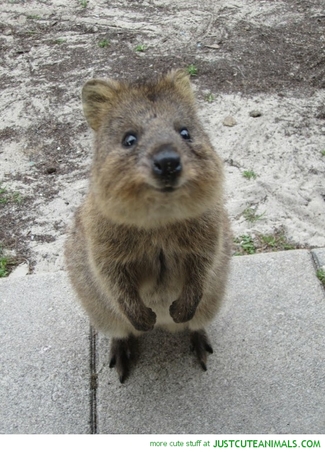Here's something furry and flufly to brighten your thursday!
The quokka (Setonix brachyurus), the only member of the genus Setonix, known in his natal country Australia as the Kangaroo Rat, is a small macropod about the size of a domestic cat. Like other marsupials in the macropod family (such as the kangaroos and wallabies), the quokka is herbivorous and mainly nocturnal. It can be found on some smaller islands off the coast of Western Australia, in particular on Rottnest Island just off Perth and Bald Island near Albany. A small mainland colony exists in the protected area of Two Peoples Bay Nature Reserve, where they co-exist with Gilbert's potoroo.
It weighs 2.5 to 5 kilograms and is 40 to 90 centimetres long with a 25 to 30 centimetres (9.8 to 12 in)-long tail, which is fairly short for a macropod. It has a stocky build, rounded ears, and a short, broad head. Although looking rather like a very small kangaroo, it can climb small trees and shrubs. Its coarse fur is a grizzled brown colour, fading to buff underneath. The quokka has no fear of humans and it is common for it to approach them closely, particularly on Rottnest Island. It is, however, illegal for members of the public on Rottnest Island to handle the animals in any way. Which is kind of lame, I mean, look at how cute they can be!
In the wild, its roaming is restricted to a very small range in the South-West of Western Australia, with a number of small scattered populations on the mainland, one large population on Rottnest Island and a smaller population on Bald Island near Albany. On Rottnest, quokkas are common and occupy a variety of habitats ranging from semi-arid scrub to cultivated gardens.
Although numerous on the small offshore islands, it has a very restricted range and is classified as vulnerable. On the mainland, where it is threatened by most introduced predatory species such as foxes, it requires dense ground cover for refuge. Clearfell logging and agricultural development has reduced this habitat, thus contributing to the decline of the species. The introduction of cats and dogs, as well as dingoes, has added to the problem, as has the clearing and burning of the remaining (swamp) lands. Moreover, Quokkas usually have a litter size of one and successfully rear one young each year. Although these animals are constantly mating, usually one day after their young is born, the small litter size paired with the restricted space and threatening predators contribute to the scarcity of these marsupials on the mainland.
The quokka (Setonix brachyurus), the only member of the genus Setonix, known in his natal country Australia as the Kangaroo Rat, is a small macropod about the size of a domestic cat. Like other marsupials in the macropod family (such as the kangaroos and wallabies), the quokka is herbivorous and mainly nocturnal. It can be found on some smaller islands off the coast of Western Australia, in particular on Rottnest Island just off Perth and Bald Island near Albany. A small mainland colony exists in the protected area of Two Peoples Bay Nature Reserve, where they co-exist with Gilbert's potoroo.
It weighs 2.5 to 5 kilograms and is 40 to 90 centimetres long with a 25 to 30 centimetres (9.8 to 12 in)-long tail, which is fairly short for a macropod. It has a stocky build, rounded ears, and a short, broad head. Although looking rather like a very small kangaroo, it can climb small trees and shrubs. Its coarse fur is a grizzled brown colour, fading to buff underneath. The quokka has no fear of humans and it is common for it to approach them closely, particularly on Rottnest Island. It is, however, illegal for members of the public on Rottnest Island to handle the animals in any way. Which is kind of lame, I mean, look at how cute they can be!
In the wild, its roaming is restricted to a very small range in the South-West of Western Australia, with a number of small scattered populations on the mainland, one large population on Rottnest Island and a smaller population on Bald Island near Albany. On Rottnest, quokkas are common and occupy a variety of habitats ranging from semi-arid scrub to cultivated gardens.
Although numerous on the small offshore islands, it has a very restricted range and is classified as vulnerable. On the mainland, where it is threatened by most introduced predatory species such as foxes, it requires dense ground cover for refuge. Clearfell logging and agricultural development has reduced this habitat, thus contributing to the decline of the species. The introduction of cats and dogs, as well as dingoes, has added to the problem, as has the clearing and burning of the remaining (swamp) lands. Moreover, Quokkas usually have a litter size of one and successfully rear one young each year. Although these animals are constantly mating, usually one day after their young is born, the small litter size paired with the restricted space and threatening predators contribute to the scarcity of these marsupials on the mainland.
~Ally

 RSS Feed
RSS Feed